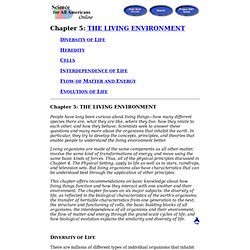

INTRODUCTION: THE NATURE OF SCIENCE AND BIOLOGY. Chapter 5: The Living Environment. Chapter 5: THE LIVING ENVIRONMENT People have long been curious about living things—how many different species there are, what they are like, where they live, how they relate to each other, and how they behave.

Scientists seek to answer these questions and many more about the organisms that inhabit the earth. In particular, they try to develop the concepts, principles, and theories that enable people to understand the living environment better. Living organisms are made of the same components as all other matter, involve the same kind of transformations of energy, and move using the same basic kinds of forces. Thus, all of the physical principles discussed in Chapter 4, The Physical Setting, apply to life as well as to stars, raindrops, and television sets. This chapter offers recommendations on basic knowledge about how living things function and how they interact with one another and their environment. The preservation of a diversity of species is important to human beings. Sunny Meadows. Gould League - Food Webs - build your own. Bacterial Cell. Science Lesson Plans and Resources. Principles of Ecology. The Good, The Bad, & The Ugly - A Microorganisms WebQuest. There is a world we can’t see.

This world is all around us. There are thousands of different organisms. We can’t live without them. They make us healthy. They help us digest our food. The Good Explore-a-Pond Worksheet What lives in a pond? Passport to Pond World Assignment After you have completed the Explore-a-Pond worksheet, it's time to complete your Passport to Pond World. Amoeba Enchanted Learning - Amoeba The Amoebae Euglena The Euglena Euglena's Home Page Paramecium Science 101 - The Paramecium (scroll to the bottom of the page to the table "Relationships in Nature") The Paramecium Stentor Microbus - Stentor The Stentor Stentor Being Eaten "My Job" Worksheet What role do microorganisms play in our environment? First, visit the Microbe Zoo to learn about bacteria.
Next, learn about fungi. The Bad What diseases are caused by microorganisms? What about fungi? Back to The Good Microbe Shopping Worksheet Your probably getting hungry about now. The Ugly (Just thought I'd throw that in!) Finished. I Need to Go to the Nurse ...... Class 6: Project. Ecology / Environment Games. 85 free fun and educational games The Ecology and Environment subject teaches your child about the interdependence of life and the ways in which organisms affect, and are affected by, their environment.

These games teach valuable skills and have a high fun and educational rating. Your child develops dance and movement skills as well as an understanding of reusing materials to create music by watching this video with the cast members of the musical Stomp. 4 subjects: Dance, Ecology / Environment, Life Science, Music Your child will learn a wide variety of facts about different ecosystems on the planet (e.g., Amazon rainforest, Savanna, Rockies, Barrier reef etc.) by playing games with animals and reading about them. 4 subjects: 生命科學, 生態學/環境學, 探索/好奇, 植物/動物 Your child learns ways to recycle and the importance of helping the environment by clicking on different places in the community and answering questions in the form of a quiz. 2 subjects: Life Science, Ecology / Environment Send Feedback.
WebQuest Maker. Science: What did you learn?: Task. Your going to research a topic you have learned during the school year and create a technology project that will teach others and show your scientific knowledge.

Here are the steps to your task: 1. Keep an online journal through either the school email system or Moodle which you will share with your teacher each week. Your journal should include things such as ideas for your project(s), notes from your research, citations for references, and links to websites you are using. This will allow your teacher to monitor your progress on the project. 2. 3. 4. 5. Multimedia Presentation - choose from animoto (must be a full length not 30 seconds), VoiceThread, Prezi, PowerPoint, or some other equivalent program. Printed Media - Create a Travel Brochure, Informative Flyer and paper, Newsletter or TYPED paper with a minimum of 700 words. Website or Blog - use a free website builder such as Google or Webs.com to create a website or Google or Blogspot to create a Blog.
Science: What did you learn?: Task.